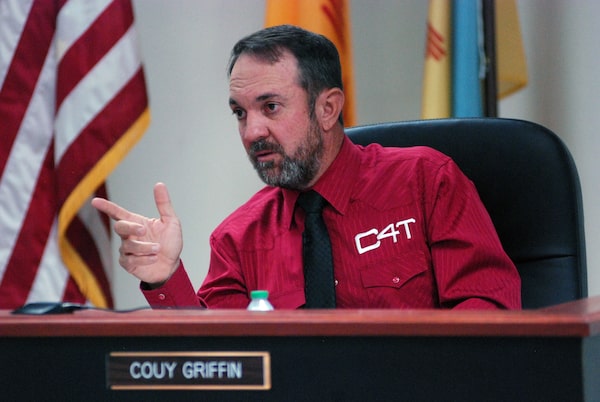
Otero County Commissioner Couy Griffin presides at a public meeting in Alamogordo, N.M., in a shirt with a 'C4T' logo that stands for Cowboys for Trump, on May 13, 2021.Morgan Lee/The Associated Press
An elected official from New Mexico went to trial Monday with a judge – not a jury – set to decide if he is guilty of charges that he illegally entered the U.S. Capitol grounds on the day a pro-Trump mob disrupted the certification of Joe Biden’s presidential election victory.
That’s not the only unusual feature of the case against Otero County Commissioner Couy Griffin, whose trial in Washington, D.C., is the second among the hundreds of people charged with federal crimes related to the Jan. 6, 2021, siege.
Griffin is one of the few riot defendants who isn’t accused of entering the Capitol or engaging in any violent or destructive behaviour. He claims he has been selectively prosecuted for his political views.
Griffin, one of three members of the Otero County Commission in southern New Mexico, is among a handful of riot defendants who either held public office or ran for a government leadership post in the 2 1/2 years before the attack.
He is among only three riot defendants who have asked for a bench trial, which means a judge will decide his case without a jury. U.S. District Court Judge Trevor McFadden is scheduled to hear one day of testimony.
Griffin, a 48-year-old former rodeo rider and former pastor, helped found a political committee called Cowboys for Trump. He had vowed to arrive at the courthouse on horseback. Instead, he showed up on Monday as a passenger in a pickup truck that had a horse trailer on the back.
Griffin is charged with two misdemeanours: entering and remaining in a restricted building or grounds and disorderly and disruptive conduct in a restricted building or grounds.
Defense attorney Nicholas Smith said prosecutors apparently believe Griffin engaged in disorderly conduct by peacefully leading a prayer on the Capitol steps.
“That is offensive and wrong,” Smith told the judge during his brief opening statements.
Prosecutors didn’t give any opening statements. Their first witness was Matthew Struck, who joined Griffin at the Capitol and served as his videographer. Struck has an immunity deal with prosecutors for his testimony.
After attending then-President Donald Trump’s “Stop the Steal” rally on Jan. 6, Griffin and Struck walked over barriers and up a staircase to enter a stage that was under construction on the Capitol’s Lower West Terrace for Biden’s inauguration, according to prosecutors.
Prosecutors played video clips that showed Griffin moving through the mob that formed outside the Capitol, where police used pepper spray to quell rioters.
“I love the smell of napalm in the air,” Griffin said in an apparent reference to a line by Robert Duvall’s character in the war movie “Apocalypse Now.”
After climbing over a stone wall and entering a restricted area outside the Capitol, Griffin said, “This is our house we should all be armed,” according to prosecutors. He called it “a great day for America” and added, “The people are showing that they have had enough,” prosecutors said.
Struck testified that he and Griffin went to the Capitol to find a place to pray. Smith asked Struck if anybody appeared to be “riled up” by the prayer that Griffin led.
“They started chanting, `Pray for Trump,”' Struck replied. “It looks like they’ve been calm and they’re listening to Couy.”
In a court filing, prosecutors called Griffin “an inflammatory provocateur and fabulist who engages in racist invective and propounds baseless conspiracy theories, including that Communist China stole the 2020 Presidential Election.”
Griffin’s attorneys say hundreds if not thousands of other people did exactly what Griffin did on Jan. 6 and haven’t been charged with any crimes.
“The evidence will show that the government selected Griffin for prosecution based on the fact that he gave a speech and led a prayer at the Capitol, that is, selected him based on protected expression,” they wrote.
More than 770 people have been charged with federal crimes related to the Capitol riot. More than 230 riot defendants have pleaded guilty, mostly to misdemeanours, and at least 127 of them have been sentenced. Approximately 100 others have trial dates.
Earlier this month, a jury convicted a Texas man, Guy Wesley Reffitt, of storming the Capitol with a holstered handgun in the first trial for a Capitol riot defendant. Jurors also convicted him of obstructing Congress from certifying the Electoral College vote on Jan. 6, of interfering with police officers who were guarding the Capitol and of threatening his two teenage children if they reported him to law enforcement.
Reffitt’s conviction on all charges could give prosecutors more leverage in negotiating plea deals in many other cases or discourage other defendants from going to trial. The outcome of Griffin’s trial also could have a ripple effect, helping others to decide whether to let a judge or a jury decide their case.
Struck was listed as one of three government witnesses. Prosecutors also intend to call a Capitol police inspector and a U.S. Secret Service inspector.
A key question in Griffin’s case is whether he entered a restricted area while Pence was still present on Capitol grounds, a prerequisite for the U.S. Secret Service to invoke access restrictions. Griffin’s attorneys say Pence had already departed the Capitol before the earliest that Griffin could have entered a restricted area.
“The Government responds that the Vice President’s precise location ultimately doesn’t matter,” the judge wrote in an order issued on Friday. “Perhaps, although the lack of clarity about the metes and bounds of the restricted area and the Vice President’s movements on January 6th undermine this argument.”
Our Morning Update and Evening Update newsletters are written by Globe editors, giving you a concise summary of the day’s most important headlines. Sign up today.